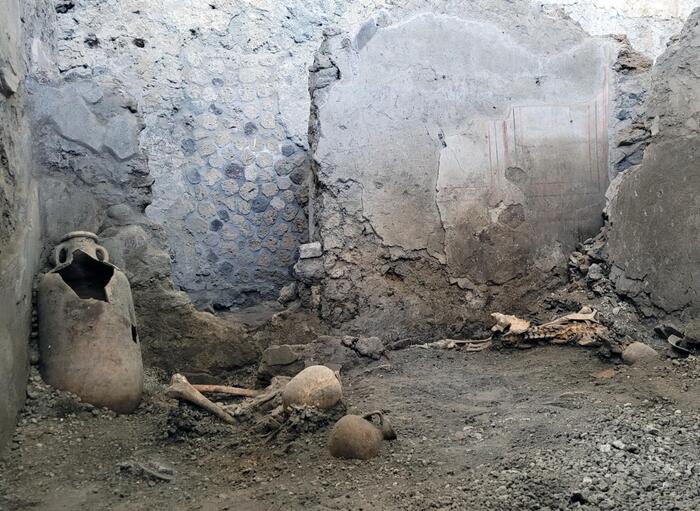It was not only the eruption that caused the death of the inhabitants of the area but also a concomitant earthquake: in Pompeii the skeletons of two new victims were found, during an excavation in the Insula dei Casti Amanti.
They are the victims of an earthquake that accompanied the eruption, found under the collapse of a wall that occurred between the final phase of sedimentation of lapilli. This was announced by the MiC. "Modern excavation techniques help us to better understand the hell that in two days completely destroyed the city of Pompeii, killing many inhabitants", explains the director of the Park, Gabriel Zuchtriegel.
The skeletons were found during the construction site of safety, reconstruction of the roofs and reprofiling of the excavation fronts of the Insula dei Casti Amanti, which is also providing for excavation interventions in some environments. They lay on one side, in a service environment, at the time in dismissal for probable repairs or renovations in progress in the house, in which they had taken refuge in search of protection. The note of the Ministry of Culture also explains. Data from early anthropological field analyses – published in the Pompeii excavation E-journal – indicate that both individuals probably died due to multiple traumas caused by the collapse of parts of the building. They were probably two male individuals at least 55 years old.
During the removal of the cervical vertebrae and skull of one of the two skeletons, traces of organic material emerged, probably a cloth wrap. Inside were found, in addition to five elements in glass paste identifiable as vagues of necklace, six coins. Two silver denarii: a republican denarius, datable to the middle of the second century BC, and another denarius, more recent, to refer to the productions of Vespasian. The remaining bronze coins (two sesterces, an axis and a quadrant), were also minted during the principality of Vespasian and therefore newly minted. In the room where the bodies lay, some objects also emerged, such as a vertical amphora leaning against the wall in the corner near one of the bodies and a collection of vases, bowls and jugs stacked against the back wall. The most impressive thing is the evidence of damage suffered by two walls, probably, due to the earthquakes that accompanied the eruption. Part of the south wall of the room collapsed hitting one of the men, whose raised arm perhaps refers to the tragic image of a vain attempt to protect themselves from the fall of the masonry. The conditions of the west wall, on the other hand, demonstrate the dramatic force of the earthquakes contextual to the eruption: the entire upper section broke off and fell into the room, overwhelming and burying the other individual.
The adjacent room houses a masonry kitchen counter, temporarily out of use in 79 AD: on its surface there is in fact a pile of powdered lime waiting to be used in construction activities, which suggests that at the time of the eruption repairs were being carried out nearby. Along the kitchen wall is a series of Cretan amphorae, originally used for transporting wine. Above the kitchen counter, traces of a domestic sanctuary in the form of a fresco that seems to depict the lares of the house and a ceramic vase partially embedded in the wall that may have been used as a receptacle for religious offerings. Next to the kitchen, moreover, a long and narrow room with a latrine, the contents of which would flow into a drainage channel under the street. The scientific details of the excavation can be deepened through the articles published in the E-Journal of Pompeii - downloadable from the official website of the Park www.pompeiisites.org - a new digital platform aimed at the scientific community and the public and aimed at providing news and preliminary reports regarding excavation, research and restoration projects in the Park's premises.

